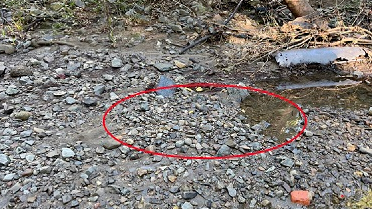Last week biologists with Marin Water observed just one adult Coho Salmon, marking the end of the 2021-22 spawning run. The data are still being compiled and validated, but it looks like the final redd count will exceed 300, making this the seventh-largest Coho Salmon run in the last 25 years. That’s very good, especially considering that high stream flows kept us out of Lagunitas Creek for an entire month. Salmon spawned from the lowest parts of the watershed to small headwater streams, and the hundreds of thousands of eggs laid were never threatened by high stream flows. We’re looking forward to a large population of Coho Salmon fry this summer.
Unfortunately the unusually dry winter has been a double-edged sword. In tributary streams (San Geronimo Creek, Devil’s Gulch, Olema Creek, and others) many redds are being exposed to the air as stream flows drop. Eggs and newly-hatched fish (called alevins) that remain submerged can survive low flow conditions, but those alevins will be trapped in the gravel if their redds aren’t fully inundated. Coho Salmon have evolved to play the odds; in some years, eggs in large streams are washed away, while in other years eggs in small streams dry out. When lots of salmon return, have access to many streams, and can follow a variety of reproductive strategies (all of which happened this year), enough will succeed to keep the population going for another generation.
Not to be forgotten, mid-February is peak steelhead season, or at least it should be. We’ve observed 47 steelhead redds, which is roughly half of average for this date. Many more steelhead could be waiting for rain before migrating upstream. Hopefully, rain will arrive in time for the big fish to spawn, and the tiny fish to escape their redds.
- Eric Ettlinger, Aquatic Ecologist

_1_1.png)
A Coho Salmon redd (circled) is exposed in San Geronimo Creek.
 Translate
Translate